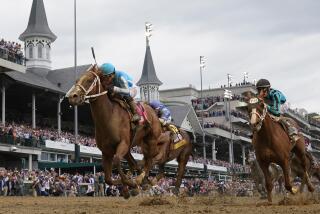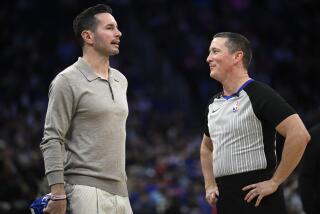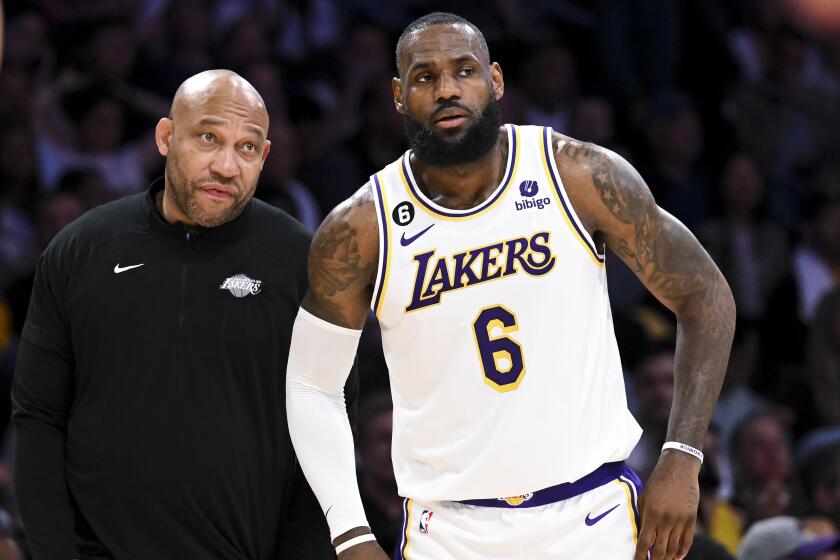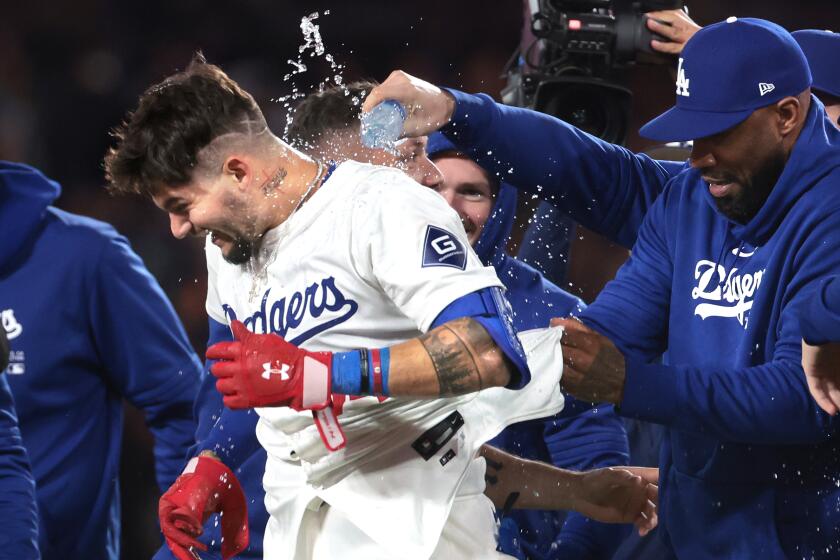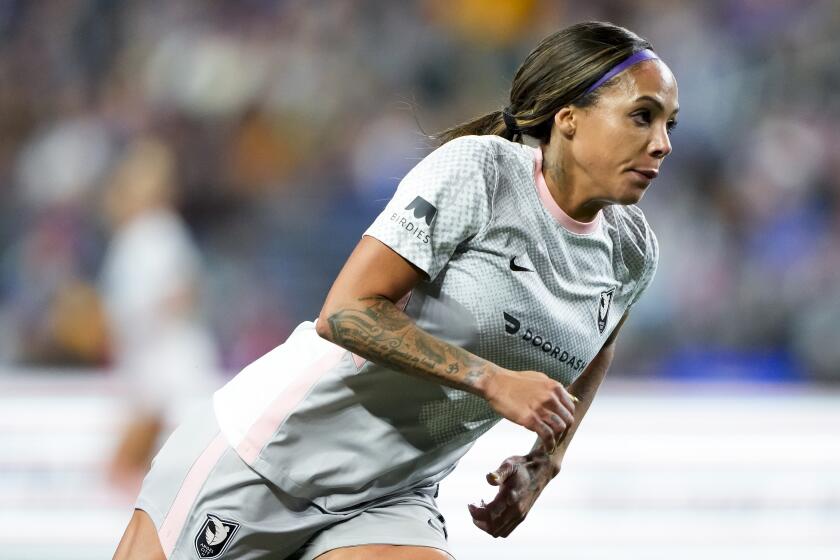PRO FOOTBALL : Minority Rules in Fight for Free Agency
For some time, it has been apparent that pro football’s four-year-long labor war is no longer that. At bottom, it isn’t so much a disagreement between the NFL’s players and club owners as much as it is a disagreement between factions of owners.
A small but powerful minority opposes any form of free agency, which, though historically a player goal, has come to be favored by most owners.
The NFL minority has been able to overrule the majority continuously because of a provision in the league’s constitution that grants veto rights to any eight of the 28 owners.
It also guarantees heated discussions whenever they get together, as they will today at a special NFL meeting with Commissioner Paul Tagliabue in New York.
The issue today, ostensibly, is practice squads.
But, as usual, there will be free-agency overtones when the owners consider a proposal that would give each team three to five practice players in addition to its active squad of 47.
Practice-squad salaries would average about $5,000 a week--up $4,000 from last year--and practice players would all be free agents who could sign active NFL contracts any time with any team.
Since football is a business in which the employees frequently go down with injuries, most coaches are in favor.
Yet, four teams voted against even meeting to discuss it. They are the Tampa Bay Buccaneers, Cincinnati Bengals, Phoenix Cardinals and New York Jets.
They are the NFL’s hard-core fighters against free agency. And although some of their coaches want practice squads, the owners are opposed on two counts: cost, and the fact that the idea was advanced by Tagliabue, not the owners’ Management Council.
To the council and a few of the clubs, the scary thing about the proposal is that it could be a step toward reconciliation with the players in a free-agency agreement of some kind--an agreement long resisted by the council, whose leader is Tampa Bay owner Hugh Culverhouse.
That prospect, however, doesn’t scare such owners as Norman Braman of the Philadelphia Eagles, an advocate of limited free agency, who said: “You need 21 votes to get it. And I can assure you, there would be more votes than that for free agency if the Management Council recommends it.”
Tagliabue has aligned this year with Braman and the others in the NFL majority who oppose indefinite stonewalling on labor.
Thus, some say the conflict has become a fight between the Management Council and the league office.
But that is an oversimplification. Tagliabue, with the assistance of 70% of the owners, is simply trying to pull the NFL into the 1990s.
Increasingly, the conflict in the NFL since 1982--the last year the players and owners signed a collective bargaining agreement--has matched the league’s larger and smaller franchises.
More precisely, it has matched higher-income and lower-income organizations.
Most of the owners against free agency, or leaning against it, are based in smaller population areas: Tampa, Cincinnati, Green Bay, Buffalo, Kansas City, Miami, Indianapolis, Phoenix and Pontiac, Mich.
Until recently they were saying, in effect, to the big-city owners: “Take care of us. We don’t make your kind of money. The basic problem is that we’re low-revenue teams.”
Lately, however, as tempers grow shorter, some big-city owners have been answering back, saying: “If it weren’t for us, you would be no-revenue teams.”
The fact is that more than 90% of NFL income is shared equally by the 28 clubs. Clubs in, say, Cincinnati and Green Bay will never be as well off as those in cities with large population bases, but it is plain that with 1/28th of the $1 billion or so the NFL gets annually from TV alone, they can compete vigorously.
Neal Anderson of the Chicago Bears gives Coach Mike Ditka a classic Bear running back. And along with a veteran offensive line, Anderson gives Ditka a sound running attack that has kept a no-passing team undefeated.
That is hard to do. The good Minnesota defense could concentrate all its weapons against the Bear ground game Sunday, secure in the knowledge that on a clear day, Chicago quarterback Jim Harbaugh, in a 60-minute performance, couldn’t complete more than four or five passes.
And still the Bears ran for 215 yards. At one stretch they ran on 19 consecutive plays. That is running.
What it may mean is that an old-time power party is coming Sunday at the Coliseum when the Raiders, also 3-0, meet the Bears before a crowd that the Raiders expect to exceed 60,000.
In recent years, there haven’t been many matchups like this--a pro game pairing undefeated no-passing teams--although that may be a little hard on Jay Schroeder.
The Raider quarterback, unlike Harbaugh, has thrown a scoring pass in each of the last two games.
In beating Pittsburgh Sunday, Coach Art Shell’s team was penalized only five times for 30 yards. If that isn’t characteristic Raider football, it nonetheless shows an attention to detail that has helped Shell to an 8-0 start in his two years at the Coliseum.
For the Philadelphia Eagles Sunday, quarterback Randall Cunningham came in with the kind of game that made him famous a few years ago--but not last year--and when he did, it was the luck of the Rams to be on the other side.
Cunningham didn’t do that against the San Francisco 49ers last season on a day when Joe Montana beat the Eagles with four second-half touchdown passes.
Nor did he do it in the first two games of this season. It will be said that Coach Buddy Ryan was saving him for the Rams, who, in any case, saw the greatest individual performance of the season.
When the Rams moved ahead, 14-10, with two minutes remaining in the half, Cunningham reclaimed the lead spectacularly in the next five plays. After a 27-yard scramble, declining to take the safe slide, he was wrestled down by a committee of five Rams--and came up signaling time out. Then he threw for 14 yards and a touchdown.
When the Rams closed to 27-21 eight minutes before the end of the game, Cunningham ran out the clock with one big play after another--a third-down scramble, a bomb to a third-round Eagle draft choice, Fred Barnett; a third-and-two quarterback draw, and other passes. In one second-half stretch, he completed 10 of 11.
It seemed probable a year ago that Cunningham was being restrained by the coaching of the Eagles’ offensive staff. He appeared then--as now--to be the finest running-passing quarterback in many years.
But in football, even a miracle worker needs coaching, as Montana has shown at San Francisco. If Cunningham has turned a corner, possibly it will be traced to the off-season changes Ryan made in his offensive staff.
Quote Department:
Boomer Esiason, undefeated Cincinnati quarterback, who was disappointed with his 6.9-yard passing average Sunday: “I want to keep that number over eight. It’s the most important stat in football.”
Steve Grogan, New England quarterback, on his blue-collar reputation: “I don’t like images, but if I have to have one, the ‘workingman’s quarterback’ is the one I’d pick. I (wouldn’t be) comfortable as a so-called superstar, walking into a room and expecting everyone to notice me.”
Paul Tagliabue on the advantages of being NFL commissioner: “I no longer sit in the end zone.”
More to Read
Get our high school sports newsletter
Prep Rally is devoted to the SoCal high school sports experience, bringing you scores, stories and a behind-the-scenes look at what makes prep sports so popular.
You may occasionally receive promotional content from the Los Angeles Times.
